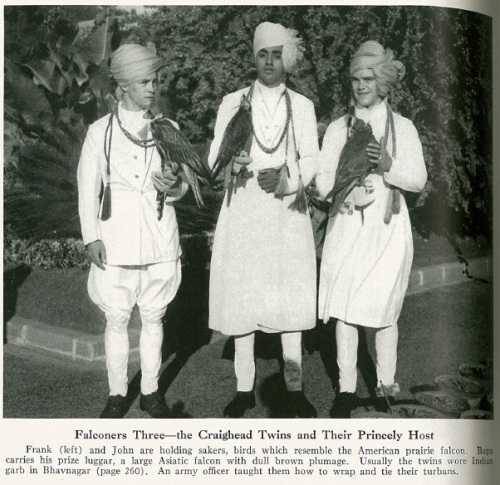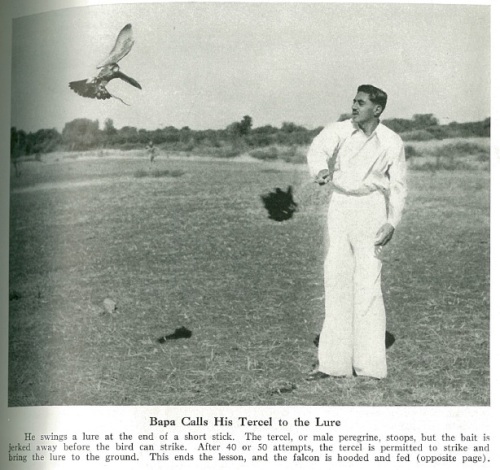After publishing their article about falconry in National Geographic, Frank and John Craighead received a letter from K. S. Dharmakumarsinhji, Bapa for short. Bapa was an Indian prince, the brother of Maharaja Sir Krishnakumarsinhji of Bhavnagar. Over the course of several years the Craigheads and Bapa exchanged letters. They discussed hunting and falconry and each of Bapa’s letters ended with “Sometime you must come and see all this for yourselves.” John and Frank, in return, invited him to America. Bapa was the first to accept and visited the Craigheads for two weeks. Wanting to return the favor and see all of the things Bapa had described the Craigheads needed to find the money to travel to India. An editor at National Geographic solved their dilemma by giving them an assignment and a grant for the trip. The Craigheads thus traveled to India and wrote “Life with an Indian Prince”, which was published in National Geographic in February, 1942.
The article reads very much like the Craigheads first, very much full of palpable adventure. It is written so well that you are transported to India with them and feel as if you’re sharing in their experiences. Also like “Adventures with Birds of Prey”, the article is filled with well-composed photographs that help bring the words to life.
“Life with an Indian Prince” focuses less on falconry than did their first article, though it is still at the heart of the story; nearly have of the photographs include a bird of prey. I really like seeing the various traps that were developed and employed in India, especially an authentic bal chatri. It’s neat that the same concept, though obviously modified, is still used today; it’s what I and most apprentices use to trap their first red-tail.
It’s also interesting to see how historic falconry in India differs from historic and modern falconry in America. For instance, the Craigheads mention catching kites and owls with their birds. Other birds of prey weren’t historically hunted for falconry in America (at least, not that I’m aware of) and they’re protected now. The Indians also employed a classical method of manning in which the bird was carried on the fist for days at a time. Handlers took shifts during the day and night and in this way the birds were tamed in a few days instead of a few weeks as they are with less intensive methods.
Bapa had his trappers catch or buy many species, including peregrines, lugger falcons, sparrow hawks, goshawks, saker falcons, and shahins (=shaheen, a subspecies of peregrine). The Craigheads wrote of eagles being trapped, but never mention if these were trained for falconry or not. Frank, John, Bapa, and Bapa’s trainers flew all of these birds. Game was apparently very abundant as many birds would be cycled through each day.
In addition to falconry and general descriptions of India and life there the Craigheads included two interesting stories. The first recounted a royal wedding the Craigheads were invited to attend, which lasted three days with little sleep. A procession of 100 elephants was involved at one point. One paragraph sums it up the best I think:
The parades were like a rotating colored disk. There were so many moving forms and colors that my lasting impression will not be the silver carriages, the trays of silks and jewels that were presented to the bride, or the gorgeously dressed groom, but it will be an image of a great color splash, as if a bubbling spring of color had overflowed at out guest palace on the hill and trickled down as a long quilted ribbon to the new palace by the lake. Even the visiting maharajas were overwhelmed by the beauty, cost, as lavishness of the ceremonies.
The second story was about hunting with cheetahs. Apparently Indian royalty imported adult cheetahs from Africa and trained them to hunt black buck, a species of antelope. Bapa’s grandfather once had a stable (what do you call a group of trained hunting cheetahs?) of thirty cats; his favorites roamed the royal palace like dogs. Bapa’s brother Nanabhai was in charge of all of the Cheetahs and apparently had fewer than thirty. Each cat cost around $400. They were hunted out of the open back of a truck. The hunted was conducted by driving around until a heard of black buck was located. Nanabhai would drive to within a few hundred yards (driving being a relative term as the Craigheads report him doing 50-70 mph across bumpy terrain, swerving around ditches and holes) of the heard, slam on the brakes, and the cheetah would be released. It may seem unsporting, but the cheetah often did not catch a black buck. At the very least, it certainly would have been something to see! I’m glad John and Frank captured it with such stunning photograph and descriptions.
After the National Geographic articles were published early in their careers, the Craigheads continued to lead lives devoted to wildlife and wildlife research. The wrote much of the “Wild and Scenic River Act” and conduced exemplary research radiotracking grizzly bears, which developed radio tracking as a tool for ecological research. Frank Craighead founded the The Craighead Institute (formerly Craighead Environmental Research Institute) in 1964, which continues the brother’s legacy of wildlife research and conservation.
*Note* All photographs in this post © National Geographic.






Pingback: “Adventures with Birds of Prey” | Skvarla Falconry